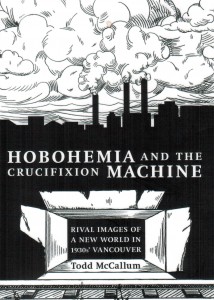The Depression, not the war, left the deepest scars on an entire generation of Canadians. Survivors carried indelible memories of the collapse of capitalism. My mother, raised on a Manitoba farmstead, years afterward could not bear to throw out tin foil pie plates. “That’s wasteful,” she warned. My father-in-law cursed TV episodes of The Waltons that depicted poor but cheerful townsfolk who had love if not money. “It wasn’t anything like that,” he said. “I was there and it wasn’t like that.”
The broad strokes of the Depression years are part of the nation’s memory, preserved in schoolbook texts and grainy newsreels: hobos on freight cars, police on horseback, dust storms and factory closures. Yet it’s the fine details that paint the most vivid picture of whole communities brought to their knees by an economic calamity unmatched in its cruelty.
Historian Todd McCallum of Dalhousie University has written a startling book. Hobohemia documents the Dustbowl Years in British Columbia, a “homeland for beggars,” he calls it, where thousands of jobless settled in shantytowns at the railways’ last stop. “Everywhere I turned, archives offered me dusty examples of a multitude of ways of seeing the hobo jungle as an island unto itself, something simultaneously connected to and separate from ‘society’, whatever one took that to mean.”
McCallum details British Columbia’s descent into chaos. In Kamloops, so many vagrants gathered the mayor sent an urgent petition to the legislature. “The town is being overrun by beggars and panhandlers,” he wrote. “Where is it all going to end?”
In Vancouver one Christmas headline in the Province read: “Man Starves To Death Here”. Ratepayers were overwhelmed by the cost of food for the jobless. The welfare budget peaked at a staggering $1.1 million by 1935, divvied up by 25¢ meal tickets. City Council telegraphed the Prime Minister: “The situation in Vancouver is beyond our control.”
In Victoria, the city launched a desperate boondoggle to put vagrants to work chopping firewood. Officials bought a campsite for $900, then provided $613 worth of saws, hired a cook and offered jobless men $1 a day to chop a cord of wood with room and board provided. Of 229 men who registered, a quarter couldn’t cut wood anyway. Victoria ratepayers were stuck with a stockpile of 2,000 cords trucked to market – that cost another $3.50 a cord – and saw the wood sold at a loss, 75¢ a cord.
“It is in every way easier for most North Americans to imagine the complete and utter destruction of the planet we currently inhabit than to envision the end of the capitalist order,” says McCallum. That is precisely what B.C. faced in the 1930s. The result was a kind of madness.
The number of transients in Vancouver was estimated at 12,000. They gathered in hobo jungles cobbled from cardboard and the city’s waste. “Grounds are filthy and covered with decaying garbage, with open toilets,” the city’s medical officer of health wrote in 1931 following a typhoid outbreak. “Flies swarm over everything and then on all open food.”
Hobohemia is meticulously researched. Professor McCallum is a gifted writer. The story is raw and compelling. To read it is to learn why children of the 1930s could never, ever waste tin foil or see their memories of gnawing despair transformed into a TV drama.
By Holly Doan
Hobohemia and the Crucifixion Machine: Rival Images of a New World in 1930s Vancouver; by Todd McCallum; Athabasca University Press; 319 pages; ISBN 9781-9268-36287; $29.95






